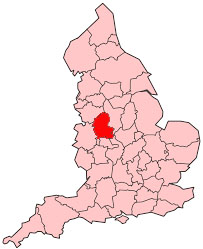Staffordshire
Staffordshire
Country: England
Region: West midlands
Established: Ancient
Area: 2,713 km2 (1,047 sq mi)
Population: 1,131,052
Largest settlement:
Stoke-On-Trent (258,366 pop.)
Staffordshire is a county in West Midlands. It borders Cheshire to the north west, Derbyshire and Leicestershire to the east, Warwickshire to the south east and Shropshire to the west.
The name Staffordshire is an English surname originating from Staffordshire which may derive from Anglo-Saxon meaning 'landing stage by the ford'.
Staffordshire contains a number of Iron Age tumuli and Roman camps . The county was formed in the early tenth century, when Stafford became the capital of Mercia. a large number of barrows have been discovered, which human bones, urns, fibulae, stone hammers, armlets, pins, pottery and other articles have been found inside.
The county symbol, the Staffordshire Knot, is seen on an Anglian stone cross that dates from around 805. The cross still stands in Stoke churchyard. The Knot is either an ancient Mercian symbol or a symbol adopted from the Irish Christianity brought by Irish monks from Lindisfarne about AD 650.
Staffordshire was invaded in the 6th century by a tribe of Angles who settled about Tamworth and later made their way beyond Cannock Chase
During the Norman conquest Staffordshire opposed William the Conqueror and was punished by ruthless harrying and confiscation. The Domesday Survey records evidence of the depopulated and impoverished condition of the county, which at the time only contained 64 mills.
A large proportion of Staffordshire in Norman times was waste and uncultivated ground, but the moorlands of the north had excellent pasturage for sheep.
In the 13th century there were some mines of coal and iron
In the 15th century both coal and iron were extensively worked.
In the English Civil War of the 17th century Staffordshire supported the parliamentary cause
in the 17th century the north of the county yielded coal, lead, copper, marble and millstones, while the rich meadows maintained great dairies. The woodlands of the south supplied timber, salt, black marble and alabaster. The clothing trade was flourishing and hemp and flax were grown all over the county. Staffordshire became a centre of ceramic production in the early 17th century due to the local availability of clay, salt, lead and coal.
By the late 18th century North Staffordshire was the largest producer of ceramics in Britain
The Staffordshire Hoard, discovered in a field near Lichfield in July 2009, is perhaps the most important collection of Anglo-Saxon objects found in England. It is estimated to date back to the 7th or 8th century.
Several of the world's largest pottery manufacturers are based in Staffordshire.

